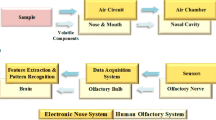Abstract
Four rice samples of long grain type were tested using an electronic nose (Cyranose-320). Samples of 5 g of each variety of rice were placed individually in vials and were analyzed with the electronic nose unit consisting of 32 polymer sensors. The Cyranose-320 was able to differentiate between varieties of rice. The chemical composition of the rice odors for differentiating rice samples needs to be investigated. The optimum parameter settings should be considered during the Cyranose-320 training process especially for multiple samples, which are helpful for obtaining an accurate training model to improve identification capability. Further, it is necessary to investigate the E-nose sensor selection for obtaining better classification accuracy. A reduced number of sensors could potentially shorten the data processing time, and could be used to establish an application procedure and reduce the cost for a specific electronic nose. Further research is needed for developing analytical procedures that adapt the Cyranose-320 as a tool for testing rice quality.
Similar content being viewed by others
References
Monscoor M A, Proctorc A. Volatile component analysis of commercially milled head and broken rice. Journal of Food Science, 2004, 69, 632–636.
Borjesson T, Eklöv T, Jonsson A, Sundgren H, Schnürer J. Electronic nose for odor classification of grains. Cereal Chem, 1996, 73, 457–461.
Saverio M, Simona B, Susanna B, Maria S C. The Application of Intelligent Sensor Array for Air Pollution Control in the Food Industry, Springer US, New York. 2006.
Srujan K D. Electrochemically Controlled Patterning for Biosensor Arrays, PhD Dissertation, University at Rovira I Virgili, Tarragona, Spain, 2006.
Haugen J-E, Kvaal K. Electronic nose and artificial neural network. Meat Science, 1998, 49, S273–S286.
Stetter U, Aspelmeicr A, Baberschke K. The initial AC susceptibility of Gd/W(110) films in UHV: A new method to investigate magnetism in ultra thin films. Journal of Magnetism and Magnetic Materials, 1992, 117, 183–189.
Rylander R. Dose-response relationships for traffic noise and annoyance. Archives of Environmental Health, 1986, 41, 7–10.
Bush R, Portnoy J, Saxon A, Terr A, Wood R. The medical effects of mold exposure. Journal of Allergy and Clinical Immunology, 2006, 117, 326–333.
Olsson J, Börjesson T, Lundstedt T, Schnürer J. Detection and quantification of ochratoxin A and deoxynivalenol in barley grains by GC-MS and electronic nose. International Journal of Food Microbiology, 2002, 72, 203–214.
Ahlstrom U, Borjesson E. Segregation of motion structure from random visual noise. Perception, 1996, 25, 279–292.
Patrycja C, Wojciech W. The analysis of sensor array data with various pattern recognition techniques. Sensors and Actuators B: Chemical, 2006, 114, 85–93.
Schulbach K F, Rouseff R L, Sims C A. Relating descriptive sensory analysis to gas chromatography/olfactometry ratings of fresh strawberries using partial least squares regression. Journal of Food Science, 2004, 69, 273–277.
Yoav S. Potential applications of artificial olfactory sensing for quality evaluation of fresh produce. Journal of Agricultural Engineering Research, 2000, 77, 239–258.
Shi Z B, Yu T, Zhao Q, Li Y, Lan Y B. Comparison of algorithms for an electronic nose in identifying liquors. Journal of Bionic Engineering, 2008, 5, 253–257.
Lan Y B, Zheng X Z, Wesbrook J K, Lopez J, Lacey R, Hoffmann W C. Identification of stink bugs using an electronic nose. Journal of Bionic Engineering, 2008, 5, S172–S180.
Zhang Z, Tong J, Chen D H, Lan Y B. Electronic nose with an air sensor matrix for detecting beef freshness. Journal of Bionic Engineering, 2008, 5, 67–73.
Author information
Authors and Affiliations
Corresponding author
Rights and permissions
About this article
Cite this article
Zheng, Xz., Lan, Yb., Zhu, Jm. et al. Rapid identification of rice samples using an electronic nose. J Bionic Eng 6, 290–297 (2009). https://doi.org/10.1016/S1672-6529(08)60122-5
Published:
Issue Date:
DOI: https://doi.org/10.1016/S1672-6529(08)60122-5




